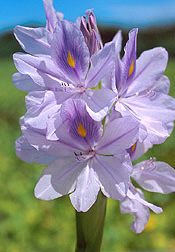|

An imported ornamental gone
bad: The natural beauty of the water-hyacinth—native to South
America—has helped it spread as a floating aquatic weed in many areas of
the U.S. Click the image for more information about it.
|
A Regional Scheme for Foiling Non-Native Plant
"Escapes"
By Luis
Pons November 29, 2004
Trees and shrubs native to other parts of the world have long spruced
up U.S. gardens and landscapes. But problems arise when some of these plants
escape cultivation to become weeds or invade natural plant communities.
That's why Agricultural Research
Service horticulturalist
Mark
Widrlechner and colleagues are retooling a strategy for assessing the risk
of such escapes across North America into something more suited for a specific
region.
This work at the ARS
North
Central Plant Introduction Station in Ames, Iowa, has produced new models
geared toward improving plant-escape predictions. The models integrate
life-history traits of woody plants found in the north-central United States
with climatic and geographic risk analysis.
Widrlechner's team collected data on 100 non-native landscape trees
and shrubs grown in Iowa, tested approaches for predicting their escape
abilities, and then compared the predictions with escape histories.
The scientists modified an existing decision tree for assessing the
risk of non-native woody plants escaping anywhere in North America by including
regionally important traits. They then designed a new decision tree featuring a
geographic-risk factor based on the plants' native distributions and selected
biological traits.
Few intentionally introduced species escape cultivation, and even
fewer become pests. But effective predictive models can reduce time and costs
associated with quarantine programs designed to spot problem plants.
Widrlechner stressed that all related models and strategies should be augmented
with long-term monitoring of sites that could be a foothold for newly
naturalizing woody plants.
This study incorporated knowledge about regional adaptation of trees
and shrubs gained through the NC7 Regional Ornamental Plant Trials. This
program, which has evaluated more than 620 accessions of woody landscape plants
under a wide range of environments, is marking its 50th year. It is funded by
the U.S. Department of Agriculture (USDA) and
12 Agricultural Experiment Stations of the North Central Region.
Details of the study and the new models were published recently in the
Journal of Environmental
Horticulture.
ARS is the USDA's chief scientific research agency.